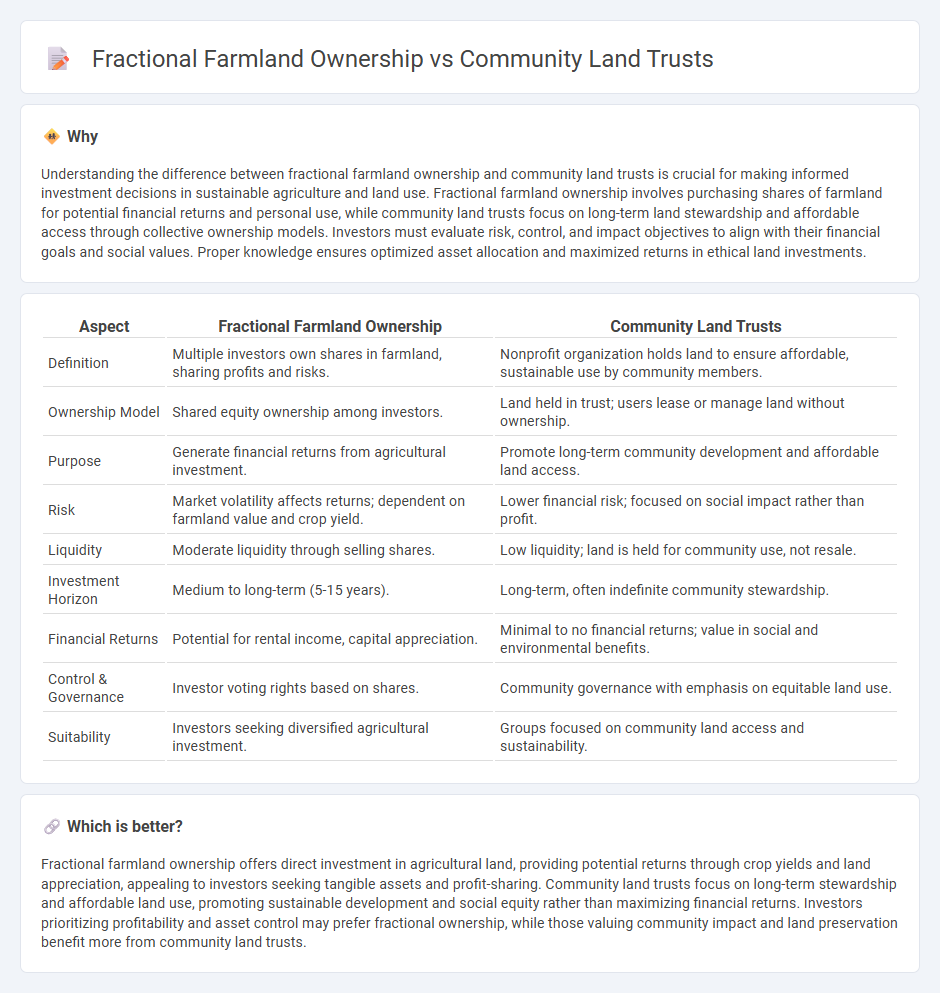
Fractional farmland ownership allows investors to buy shares in agricultural land, enabling diversification and passive income from crop yields without full land management responsibilities. Community land trusts focus on preserving land for community use and affordable access rather than individual profit, promoting sustainable development and local stewardship. Explore how these innovative models can reshape your approach to farmland investment.
Why it is important
Understanding the difference between fractional farmland ownership and community land trusts is crucial for making informed investment decisions in sustainable agriculture and land use. Fractional farmland ownership involves purchasing shares of farmland for potential financial returns and personal use, while community land trusts focus on long-term land stewardship and affordable access through collective ownership models. Investors must evaluate risk, control, and impact objectives to align with their financial goals and social values. Proper knowledge ensures optimized asset allocation and maximized returns in ethical land investments.
Comparison Table
| Aspect | Fractional Farmland Ownership | Community Land Trusts |
|---|---|---|
| Definition | Multiple investors own shares in farmland, sharing profits and risks. | Nonprofit organization holds land to ensure affordable, sustainable use by community members. |
| Ownership Model | Shared equity ownership among investors. | Land held in trust; users lease or manage land without ownership. |
| Purpose | Generate financial returns from agricultural investment. | Promote long-term community development and affordable land access. |
| Risk | Market volatility affects returns; dependent on farmland value and crop yield. | Lower financial risk; focused on social impact rather than profit. |
| Liquidity | Moderate liquidity through selling shares. | Low liquidity; land is held for community use, not resale. |
| Investment Horizon | Medium to long-term (5-15 years). | Long-term, often indefinite community stewardship. |
| Financial Returns | Potential for rental income, capital appreciation. | Minimal to no financial returns; value in social and environmental benefits. |
| Control & Governance | Investor voting rights based on shares. | Community governance with emphasis on equitable land use. |
| Suitability | Investors seeking diversified agricultural investment. | Groups focused on community land access and sustainability. |
Which is better?
Fractional farmland ownership offers direct investment in agricultural land, providing potential returns through crop yields and land appreciation, appealing to investors seeking tangible assets and profit-sharing. Community land trusts focus on long-term stewardship and affordable land use, promoting sustainable development and social equity rather than maximizing financial returns. Investors prioritizing profitability and asset control may prefer fractional ownership, while those valuing community impact and land preservation benefit more from community land trusts.
Connection
Fractional farmland ownership allows multiple investors to hold shares in agricultural land, promoting access and diversification while preserving farmland's productive use. Community land trusts often adopt this model to maintain affordable farmland by preventing speculative development and ensuring long-term stewardship. Both approaches enhance sustainable investment by aligning financial returns with land conservation and community benefit goals.
Key Terms
Land Tenure
Community land trusts secure long-term land tenure by holding land collectively and leasing it to members, ensuring affordability and preventing speculation. Fractional farmland ownership divides property into shares, giving investors limited, proportional control without full title, which may complicate land use decisions and tenure security. Explore how these models impact sustainable land tenure and community empowerment.
Ownership Structure
Community land trusts establish collective ownership where the land is held by a nonprofit entity, ensuring long-term affordability and stewardship, while individual members lease properties without acquiring the land itself. Fractional farmland ownership divides the land into shares, granting investors direct equity and decision-making rights proportional to their ownership stake, often facilitating profit-sharing from agricultural yields. Explore deeper comparisons on ownership models and benefits to determine which suits your investment or community goals best.
Governance
Community land trusts (CLTs) prioritize democratic governance involving residents and stakeholders who collectively manage land to ensure long-term affordability and community benefit. Fractional farmland ownership typically involves multiple investors sharing property rights, with governance structured through legal agreements and limited collective decision-making authority. Explore how governance impacts control, sustainability, and equity in land tenure by learning more about these models.
Source and External Links
Community Land Trusts - Community land trusts (CLTs) are nonprofit, community-based organizations that provide permanently affordable housing by owning land and leasing it to residents, governed by a board representing residents, community members, and public interests with 99-year ground leases ensuring long-term affordability and stewardship.
Community Land Trust Network | Homepage - The UK Community Land Trust Network leads efforts to mainstream community ownership of land and affordable housing, advocating for policy support to enable CLTs to provide thousands of new affordable homes annually and generate community wealth through local control of land and assets.
What Is a Community Land Trust? - A CLT is a nonprofit corporation holding land permanently off the market for community benefit, structured with a governance board balancing residents on CLT land, community members, and public interest representatives, using long-term ground leases to allow building ownership while preserving land affordability.
 dowidth.com
dowidth.com